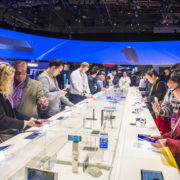Am I Built for the Future?
Here’s the thing: I’m a Gen X guy, smack dab in the digital evolution crossroads, with a suitcase full of gadgets that have turned into nothing more than high-tech doorstops. My journey began with the unforgettable screech of dial-up internet, and now, here I am, decades later, navigating through an Apple Store with eyes wide at the sight of the new Vision Pro spatial computing gear. It’s not my first rodeo with VR tech. My home’s got its fair share of what essentially turned into high-tech doorstops – from Oculus right through to PSVR2. Each time, I thought, “This is it, the game-changer,” only to find it gathering dust by the end of the weekend.
Now, staring down the barrel of Apple’s latest offering, the Vision Pro, I feel that old familiar spark of excitement. Spatial computing sounds fantastic, right? But there’s a snag for folks like me. You see, I wear hard contact lenses because of an eye condition, and it turns out, these fancy new goggles can’t do the required eye tracking with the reflection from the lenses. The high-tech promise of tomorrow is right there, yet it’s as if I’m peering at it through a window I can’t open. My vision of the future isn’t dimmed, it’s just that my pathway to experiencing it firsthand is blocked by this unwieldy headset.
But the hardware is only part of the story. The software landscape is shifting under our feet (can we escape Adobe’s grip yet?), offering a new suite of creative tools—including favorites like midjourney, rive, fable, notion, spline, capcut—that whisper promises of innovation and late nights spent in the glow of a computer screen, reminiscent of learning shockwave and flash. These platforms represent a new frontier, one that speaks a language that seems to morph just when you think you’ve got the hang of it. The parallels to what we learned 30 years ago are there, yet now, without the luxury of youth on my side, the all-nighter attitude and time commitment to learning isn’t as accessible. My learning curves aren’t what they used to be, and frankly, the nostalgia for what is familiar does creep in. This even applies to the latest video games. As much as I love Helldivers 2, the intensity is so high that I’m done after two games.
But here’s where the plot twists a bit – despite the cynical take, there’s a part of me that can’t help but be drawn to these promises of the future. Sure, my track record with the latest tech gadgets is more miss than hit, and adapting to new software feels like running on a treadmill that’s speeding up gradually. Yet, there’s something about the chase, the perpetual forward motion, that keeps me in the game.
So, am I built for the future? It’s a loaded question. Perhaps it’s less about being ready-made for what’s next and more about how we prepare ourselves for it, bit by byte. The future isn’t going to slow down or wait up; it’s on us to keep up, to keep learning, even when it feels like we’re playing catch-up more often than not.
The attitude we bring to the table matters. Staying curious, being willing to tackle the learning curves, and yes, maintaining a bit of that healthy skepticism – that’s how we’ll navigate this. It’s about resilience, about stepping out of our comfort zones and facing the new without flinching. There’s this quote I keep coming back to: “The degree to which a person can grow is directly proportional to the amount of truth they can accept about themselves without running away.” That hits home for me every single day. Daring to lean into the discomfort of learning and adapting, even when it would be much easier to stick with what we know. That notion, that growth is tied to our willingness to confront and embrace our realities, hits home for me every single day. It’s not just about adapting to new tech; it’s about evolving alongside it, daring to lean into the effort of learning and adapting, even when it would be much easier to stick with what we know.
Being prepared for the future might mean readying ourselves to mutate with it, imagining the possibilities with the enthusiasm of an up-winger futurist like FM-2030, and not taking the journey too seriously. After all, if a Gen Xer like me can stay in the race, perhaps there’s hope for all of us in this rapidly changing world.
James Rice – Chief Digital Officer









